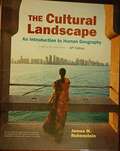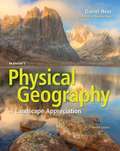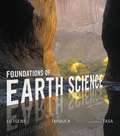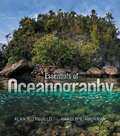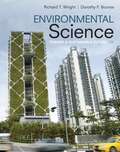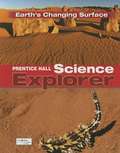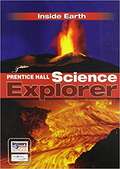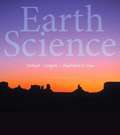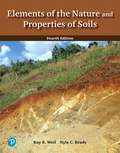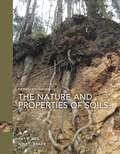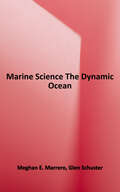- Table View
- List View
The Cultural Landscape: An Introduction To Human Geography
by James M. RubensteinThe Cultural Landscape: An Introduction to Human Geography AP Edition
McKnight's Physical Geography: A Landscape Appreciation, 12th Edition
by Darrel Hess Dennis G. TasaExplore the changing global environment with real-world examples and mobile field trips Continuing Tom L. McKnight's well-known thematic focus on landscape appreciation, Darrel Hess offers a broad survey of all of the physical processes and spatial patterns that create Earth’s physical landscape. McKnight’s Physical Geography: A Landscape Appreciation provides a clear writing style, superior art program, and abundant pedagogy to appeal to a wide variety of readers. <P><P>The 12th Edition offers a truly meaningful integration of visualization, technology, and the latest applied science, providing essential opportunities to teach and engage readers in these processes and patterns. Topics that are tied to readers’ real-world concerns such as global environmental change, along with new videos, photography, online lab resources, and updated interactive tools, make it the most effective learning program for physical geography.
Foundations of Earth Science
by Frederick K. Lutgens; Edward J. TarbuckIdeal for undergraduates with little or no science background, Foundations of Earth Science provides a student-friendly, highly visual, non-technical survey of our physical environment with balanced, up-to-date coverage of geology, oceanography, astronomy, and meteorology. Foundations of Earth Science is the brief, paperback version of the best-selling Earth Science by Lutgens and Tarbuck, and designed for introductory courses in Earth science. The new 8th Edition facilitates active learning by incorporating learning objectives throughout each chapter to provide students with a structured learning path. The learning path is tied to chapter objectives, giving students opportunities to demonstrate their understanding at the end of each section.
Transport Processes and Separation Process Principles (International Series in the Physical and Chemical Engineering Sciences)
by Christie Geankoplis Allen Hersel Daniel LepekTransport Processes and Separation Process Principles, Fifth Edition, offers a unified and up-to-date treatment of momentum, heat, and mass transfer and separations processes. This edition–reorganized and modularized for better readability and to align with modern chemical engineering curricula–covers both fundamental principles and practical applications, and is a key resource for chemical engineering students and professionals alike.
Essentials Of Oceanography
by Alan P. Trujillo Harold V. ThurmanEssentials of Oceanography guides readers through the complexities of what lies beneath the ocean. With an interdisciplinary approach and accessible writing style, the text is engaging for all readers. The 12th Edition discusses the ocean’s biological, chemical, geological, and physical components for an in-depth understanding of this vast and elaborate topic. Complex concepts are made engaging with extensively revised art and interactive study aids that keep readers interested and excited about the material.
Environmental Science: Toward a Sustainable Future
by Richard Wright Dorothy BoorseFor introductory courses in Environmental Science, Environmental Studies, and Environmental Biology. Known for its currency and readability, this text focuses on enabling students to critically evaluate the latest environmental issues and to apply that understanding to situations and events in their everyday lives. <p><p>It explores the interactions of humans within the natural environment and probes issues thoroughly examining their scientific basis, their history, and society's response. The authors discuss sustainable development and public policy in terms of how they shape the present and future.
Dynamic Earth
by Prentice HallThis book contains everything teenagers need learn about the earth. Topics covered in this book are: earthquakes, volcanoes, earth's crust, plate tectonics, rocks, minerals, weathering, soil formation, erosion and deposition
Environmental Science
by Withgott Prentice-Hall StaffTeaching environmental science is much more than just communicating facts and information. It's about engaging and motivating students. It's about helping them to better understand how and why their actions--and those around them--impact the world in which they live. <P><P> Environmental Science: Your World, Your Turn is a new high school program that brings the outside world into the classroom--making the science personal, actionable, and empowering for each student.
Prentice Hall Science Explorer Earth Science
by Jan Jenner Andrew C. Kemp Jay M. Pasachoff Barbara Brooks SimonsNIMAC-sourced textbook
Prentice Hall, World Geography, Building a Global Perspective
by Thomas J. Baerwald Celeste FraserNIMAC-sourced textbook
Prentice Hall Science Explorer Georgia Earth Science
by Michael J. Padilla Ioannis Miaoulis Martha CyrNIMAC-sourced textbook
Prentice Hall Science Explorer Georgia Earth Science
by Michael J. Padilla Ioannis Miaoulis Martha CyrNIMAC-sourced textbook
Prentice Hall Earth Science: Physical Setting/Earth Science, New York
by Edward J. Tarbuck Frederick K. Lutgens Dennis TasaNIMAC-sourced textbook
Prentice Hall Earth Science
by Edward J. Tarbuck Frederick K. Lutgens Dennis TasaNIMAC-sourced textbook
Prentice Hall Earth Science
by Edward J. Tarbuck Frederick K. Lutgens Dennis TasaNIMAC-sourced textbook
Earth Science
by Edward J. Tarbuck Frederick K. LutgensIdeal for undergraduates with little or no science background, Earth Science provides a student-friendly overview of our physical environment that offers balanced, up-to-date coverage of geology, oceanography, astronomy, and meteorology. The authors’ texts have always been recognized for their readability, currency, dynamic art program, delivery of basic principles and instructor flexibility. The Fourteenth Edition incorporates a new active learning approach, a fully updated and mobile visual program, and MasteringGeology™–the most complete, easy-to-use, engaging tutorial and assessment tool available.
Elements Of The Nature And Properties Of Soils
by Nyle Brady Raymond WeilAt the forefront of soil science for over a century, Elements of the Nature and Properties of Soils considers the role of soils as both a natural resource and an ecosystem, while highlighting interactions between soils and other components of natural and constructed ecosystems. With practical value for meeting today’s environmental challenges, the text asserts that balancing economic growth with sustainable economies requires a deep understanding of soils. The 4th edition has been abridged to focus on fundamentals, while providing new or updated discussions on topics such as soils and human health, organic farming, and soil food-web ecology.
The Nature and Properties of Soils
by Nyle Brady Ray Weil<p>This hallmark text introduces the exciting world of soils through clear writing, strong pedagogy, and an ecological approach that effectively explains the fundamentals of soil science. Worked calculations, vignettes, and current real-world applications prepare readers to understand concepts, solve problems, and think critically. Written for both majors and non-majors, this text highlights the many interactions between the soil and other components of forest, range, agricultural, wetland and constructed ecosystems. <p>Now in full-color, the Fifteenth Edition includes hundreds of compelling photos, figures, and diagrams to bring the exciting world of soils to life. Extensively revised, new and updated content appears in every chapter. Examples include: coverage of the pedosphere concept; new insights into humus and soil carbon accumulation; subaqueous soils, soil effects on human health; principles and practice of organic farming; urban and human engineered soils; new understandings of the nitrogen cycle; water-saving irrigation techniques; hydraulic redistribution, soil food-web ecology; disease suppressive soils; soil microbial genomics; soil interactions with global climate change; digital soil maps; and many others.</p>
Marine Science: The Dynamic Ocean
by Meghan E. Marrero Glen SchusterThis book is a truly integrated science course in which the science concepts are applied to authentic scientific settings, scenarios, and investigations. You will simultaneously learn about life, Earth, and physical sciences. As you explore real-world data, you get a unique and fresh perspective on the ocean, its inhabitants, and its processes. Science concepts such as plate tectonics, food and energy transfer, and the properties of water come to life as you participate in Student Expert teams that focus on the seafloor, marine food sources, and the sea's surface. <p><p>This curriculum program parallels other textbook programs, yet there are some notable distinctions in the way it was put together. Rather than chapters, the book is divided into 34 Lessons, each of which will help you to build your understanding about the ocean and its processes. Marine Science: The Dynamic Ocean gives you the opportunity to access and interpret data sets, including oceanographic, meteorological, and animal tracking observations. You will also participate in fieldwork, assessing local water quality and your school's potential contribution to marine pollution.
Physical Science: Concepts in Action
by Sophia Yancopoulos David Frank Michael WysessionNIMAC-sourced textbook
Earth Science
by Edward J. Tarbuck Frederick K. Lutgens Dennis TasaThe latest edition (fifth was 1988) of a broad and nonquantitative survey at the introductory level of topics in geology, oceanography, meteorology, and astronomy.
Earth Science
by PearsonEarth Science, 13th Edition, is designed for an 11th or 12th grade course in Earth science. It consists of seven units that emphasize broad and up-to-date coverage of basic topics and principles in geology, oceanography, meteorology, and astronomy. The book is intended to be a meaningful, nontechnical survey for students. In addition to being informative and up-to-date, Earth Science, 13th Edition strives to meet the need for a readable and user- friendly text and a highly usable "tool" for learning basic Earth science principles and concepts.
